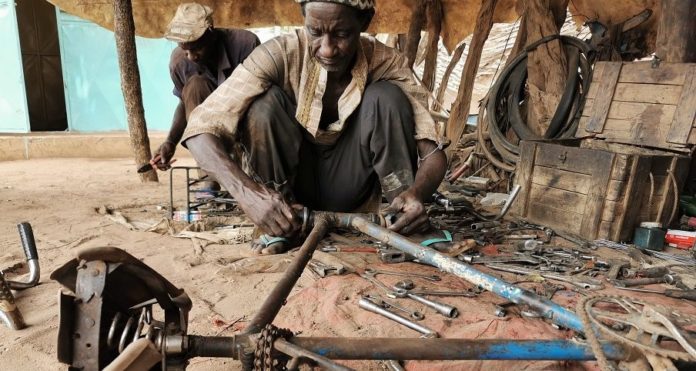By: Dr. Nimrod Israely
I arrived in this African village for yet another meeting with farmers. I see them sitting outside in the shade of a big tall mango tree.
As I get closer, I smile, and they smile back. We shake hands and sit in a big circle to talk.
After thirty minutes, I gain their trust, and they start sharing about themselves.
One of the farmers lifts his hand and asks to talk. With a shattered voice, he is saying, “I work hard every day. Yet, at the age of 55, all I have is a pair of the bicycle.” This statement hits me at 100 km per hour.
Then his friend, sitting next to him, adds, “I’m like him, but I have no bicycle.” I see his red eyes as he holds his tears, and I hold mine.
These farmers subsist on $ 1.5-3 per day. I think to myself, “None of us control where we are born, yet the place we’re born determines our future more than anything else.”
THINK DIFFERENT
I ask myself for the thousandth time, “Why do they suffer poverty? What should we do differently?”
Unlike the times before, this time I have a different answer;
“Farmers’ poverty is not due to lack of technology, money, land, water, labor, or logistics. Those contribute to poverty, but they don’t cause poverty.
The cause of poverty and hunger is too low income. The way to solve it is by establishing a mechanism that enables farmers to continuously grow their crops and revenue in a sustainable business-oriented manner.
For this end, we need to put in place a profitable system that can grow itself.”
If that sounds impossible to you, try to remember what people said about Google – making information available for everyone, or Amazon – enabling small businesses (SMEs) and individual buyers and making global trading easy and accessible.
Now we need an Amazon for smallholders/farmers to trade globally. Could it be more simple than this?
Creating prosperity is through increased national export; go global or die local.
Sadly, today’s agro sector in non-developed economies is dying. We must change this, and we can.
Our most outstanding achievements are the result of the human spirit, for it is people who change the world. Technology and finance are no more than tools.
Smallholders need to go global, for the alternatives are known and unwanted.
THE ROOT PROBLEMS
I realized that poverty was not due to a lack of technology when I had the best technology at my disposal.
Undoubtedly, technology, funds, and other things are essential for creating prosperity. But currently, they are NOT the Root Problem for smallholders’ persistent poverty.
The main challenge of non-developed economies with a sizeable agro sector is NOT the lack of access to agro-technology or funds BUT the inability to continuously increase farmers’ profit per hectare.
Once I knew what were NOT the Root Problems, I became open to looking for other possible Root Problems.
During the last four years, I identified three Root Problems that all 175 non-developed countries seem to share in common:
Vision, dedication, and committed LEADERSHIP.
Leadership enables nations to do what once seemed impossible; J.F. Kennedy’s – going to the moon; Nelson Mandela – fighting apartheid, etc. Now is the time for leaders to fight poverty.
Undeveloped agricultural ECOSYSTEM.
An advanced ecosystem would enable all stakeholders in the agro sector to work in harmony in a business-oriented environment, where they can prosper, thrive, and continuously increase their income.
Use of inappropriate BUSINESS MODELS.
To simplify, a business model is an outline of how to make money with the products and customer base in a specific market. Business models should be tailor-made per market. Unfortunately, the business models currently used in non-developed economies for the agro sector are suitable for professional farmers but not smallholders. Hence, there is a need for the introduction of novel business models.
Following is the prescription and “The Blueprint” for transferring the agro sector of non-developed economies –
FROM traditional agriculture, local market-oriented that suffer poverty,
TO an advance leading agro-industry, export-oriented, creating prosperity.
The bottom line is simple: “Go Global or Die Local.”
BONUS:
For more info on the importance of dedicated Business Models for smallholders, I suggest you re-read my recent columns. In addition, make sure not to miss the upcoming conference on the topic – the International Conference on Business Models in Agriculture (IBMA).
THE FIVE COMPONENTS
After adding Leadership, Ecosystem, and Business Models, we now have an updated list of five components required to promote the agro-sector in non-developed economies:
1. Leadership.
2. Ecosystem.
3. Business model.
4. Technology.
5. Funding
BLUEPRINT FOR CHANGE
Dream Valley National Export Program, or Dream Valley (DV) for short, is a disruptive innovative concept that packaged all needed to design, plan and execute the agro sector New Deal required by the 170 non-developed economies.
The goal of Dream Valley is to facilitate countries and their leaders to transform their agro sector, in a tailor-made fashion, according to their vision and relative advantages.
To help transform the agro sector Dream Valley has designed a complete Package, which is tailor-made per country according to its particular needs and desires.
The steps for change can be summarized as follow:
(1) Announcement of a New Deal for the agro sector.
A program can succeed if everybody involved is tuned and synchronized. Hence, it is critical to announce the dramatic changes underway, led by the government.
(2) Thoroughly studying the current state.
In many countries, smallholders and even professional ones grow what they know how to grow, not what is profitable or demanded by the markets. Even when farmers grow what the markets demand, they don’t achieve the needed quality and quantities to reach the premium markets and get premium prices. This stage focuses on a few crops that can generate the most significant profit for all value chain partners based on the country/region’s particular conditions. (Now you understand why Dream Valley’s Package is tailor-made).
(3) Agreeing on a vision and goals based on a desired future state.
To change the agro sector, numerous governmental and other stakeholders need to cooperate, or else nothing will change. For example, before export can begin, we need to establish international agreements for trade and biosecurity with the countries we wish to export to. This and much more are doable if everybody is synchronized on the same vision and goals.
(4) Program execution.
Dream Valley understands well that all the talking and plans in the world wouldn’t change without proper and precise execution of the programs. To this end, I invest much of my time in the field, making sure plans are correctly executed.
(5) Continuous updating of the goals and program according to QC reports and feedback.
No plan is perfect, and none is forever. To ensure continuous growth and success, we must keep pushing ourselves to excel. We do it by continuously looking for where we can improve and do things better than ever before.
Simultaneously to the above stages, Dream Valley would launch a small-scale demo as soon as the New Deal is announced not to waste time.
This demo is necessary for adjusting the business model to the local Ecosystem before any program expansion is possible.
Dream Valley program is not meant to apply in a year or two but over a more extended period, one crop and region at a time, to enable the Ecosystem to adjust.
ECONOMIC ENGINE
Dream Valley’s New Deal program is designed to create a rapid change with a historic magnitude impact on the agro sector of non-developed economies.
Any country out of the 170 non-developed which would adopt the Dream Valley program can expect to witness an economic impact as China experienced when it opened its gates to the West.
A rapid increase in the country’s export and farmers’ income (those in the program) are two of the notable outcome we can expect when applying for the Dream Valley New Deal program.
This translates to GDP rapid growth and positive cash flow on the scale of billions $ to the state treasury at the national level.








